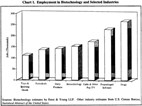Biotech industry contributes to US economy with jobs and tax revenue


Measures of the economic impact of the biotech industry presented in the report include:
Indirect Impact
In addition to direct employment and revenue generated, the biotech industry contributes indirectly to the economy through purchases made from outside industries. Ernst and Young estimates this accounts for some $4.8 billion in revenue and an additional 45,000 employees. They also calculated what they called induced impact, based on the purchasing power generated from the salaries paid to biotech industry workers. Their estimates of induced impact are an additional $21 million dollars and almost 250,000 employees. Taken together, this leads to the conclusion that for every biotech job, 2.9 jobs are created outside the industry to provide for the needs of that person.
Public versus Private
According to Ernst and Young, publicly traded companies generated about twice the amount of jobs and revenues as privately held companies, with publicly traded companies employing over 300,000 workers and generating $32 in revenues.
A major beneficiary of all this activity is the American public, in terms of tax revenue generated. This report claims that nearly $10 billion in tax revenue was generated in 1999, the main source being individual income taxes paid by employees and owners. In addition, biotech companies generated another billion dollars in corporate taxes, directly and indirectly through companies that serve the industry.
The Best is Yet to Come
And all this with an unprofitable industry. Imagine the future, when the new generation of biotech drugs hits the marketplace.
For more information, contact: Biotechnology Industry Organization (BIO), 1625 K Street, NW, Suite 1100, Washington, DC 20006, 202-857-0244
Edited by Laura DeFrancesco
1. The study focuses on US companies engaging primarily in biotechnology activities, including medical biotechnology (companies such as Amgen and Genentech), agricultural biotechnology (for example, Mycogen) and environmental and industrial biotechnology. Excluded from the study were pharmaceutical companies, contract research organizations, and equipment manufacturers.
